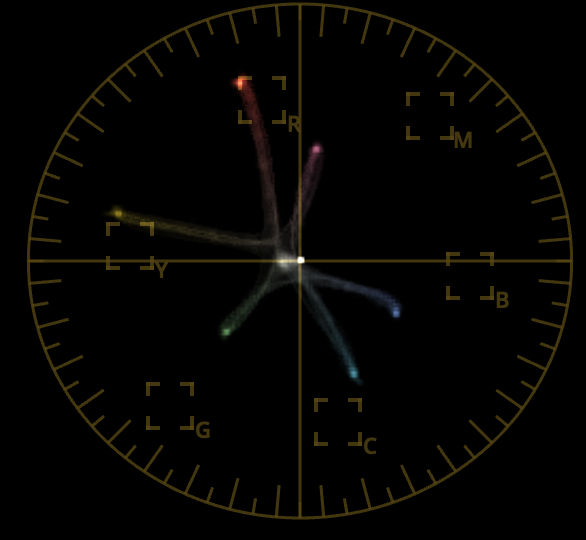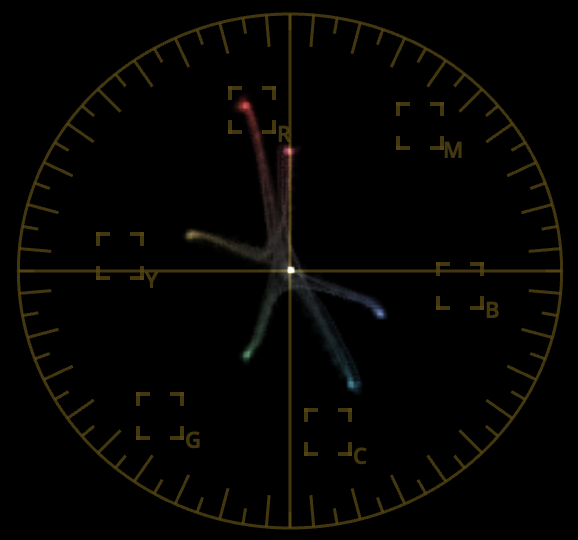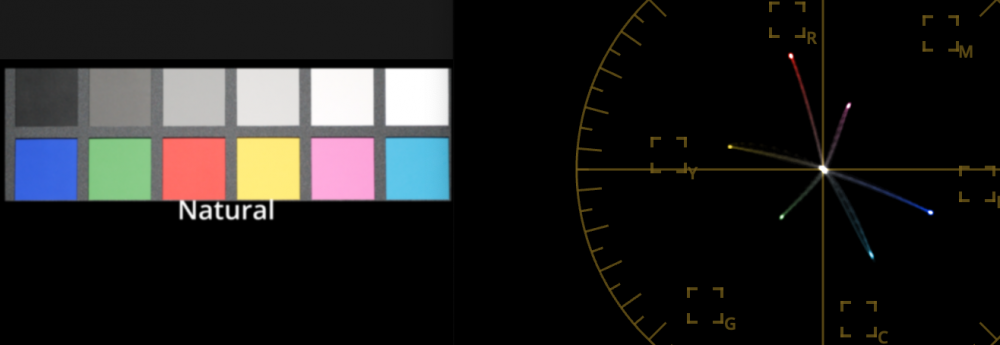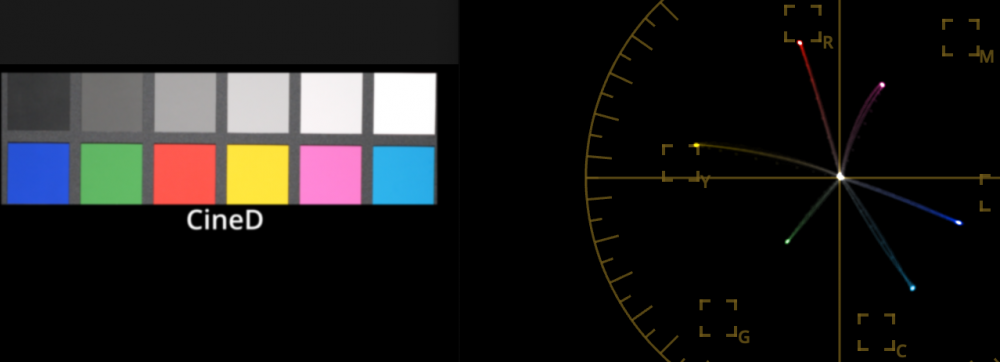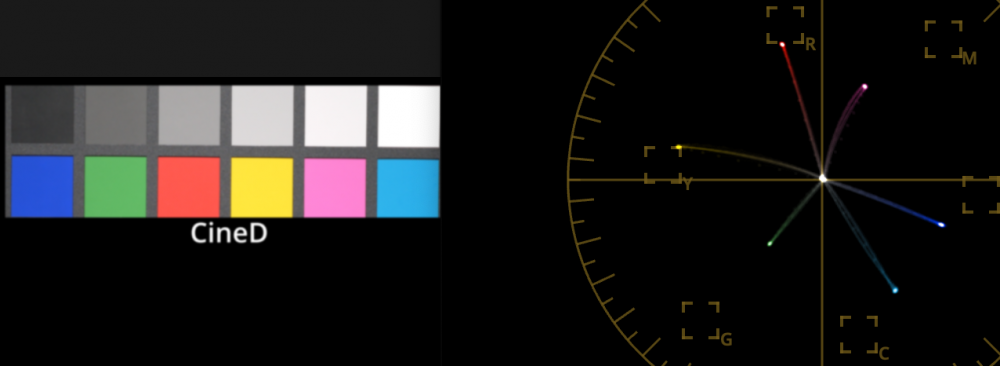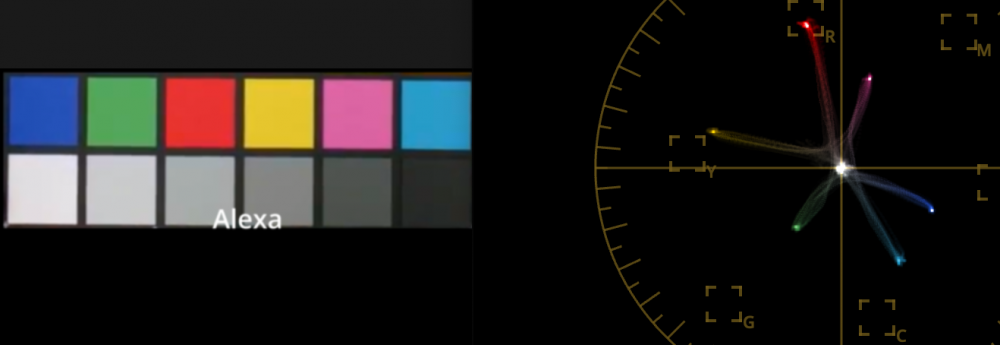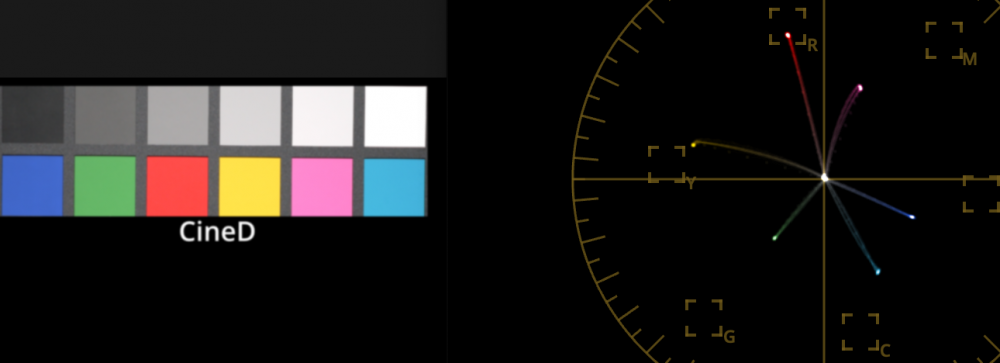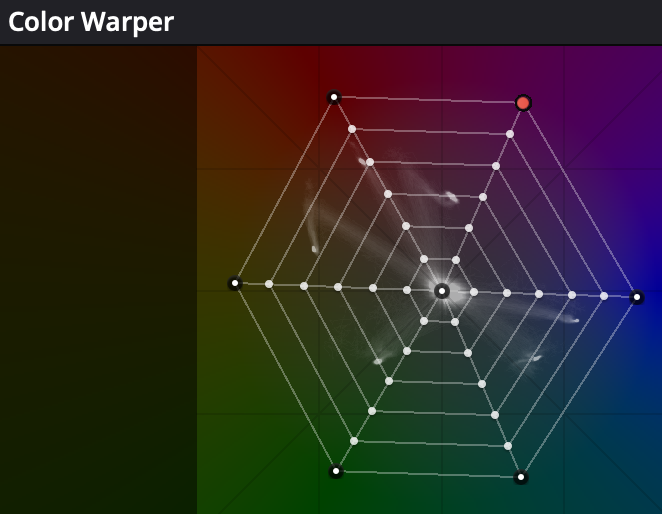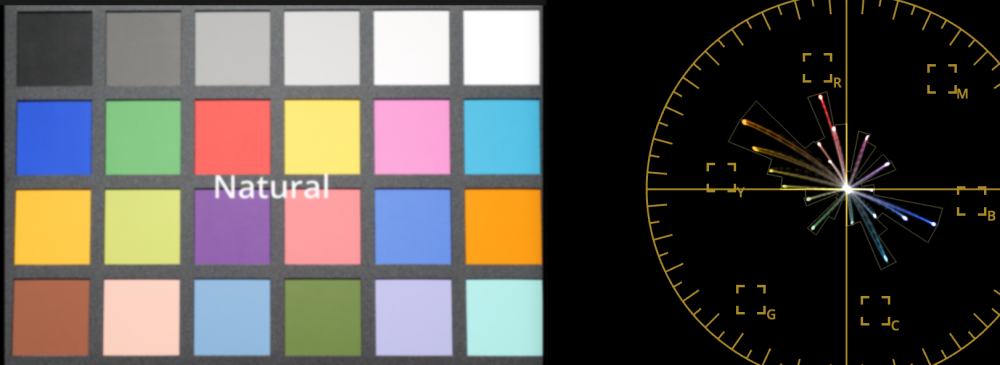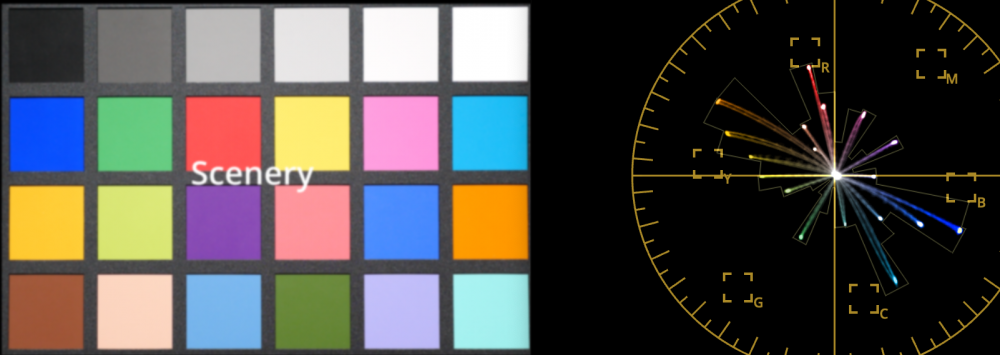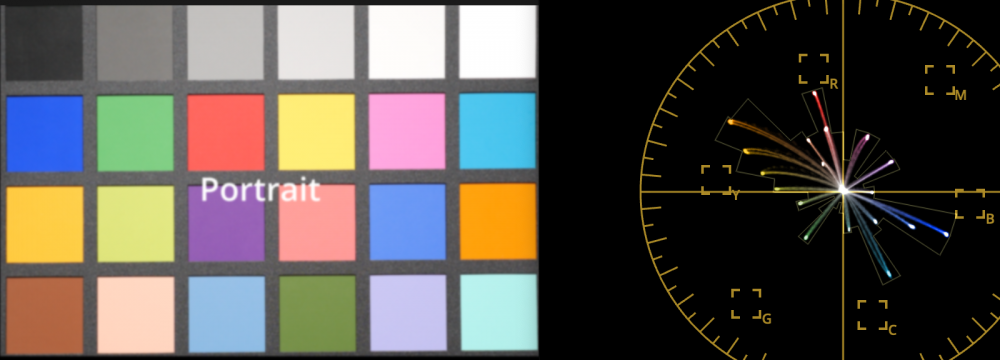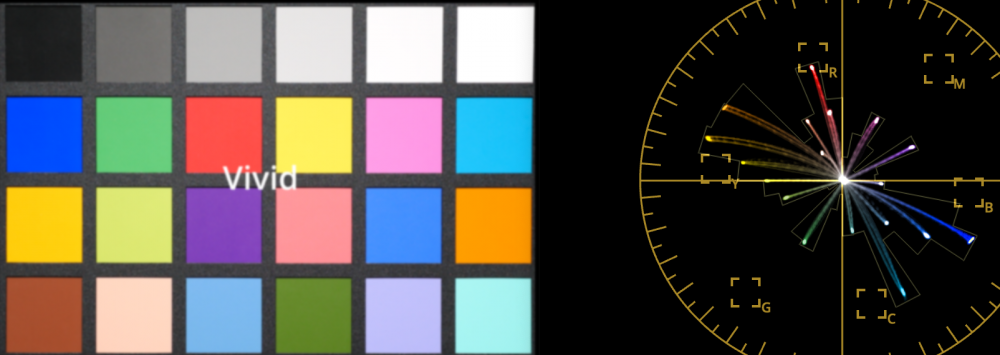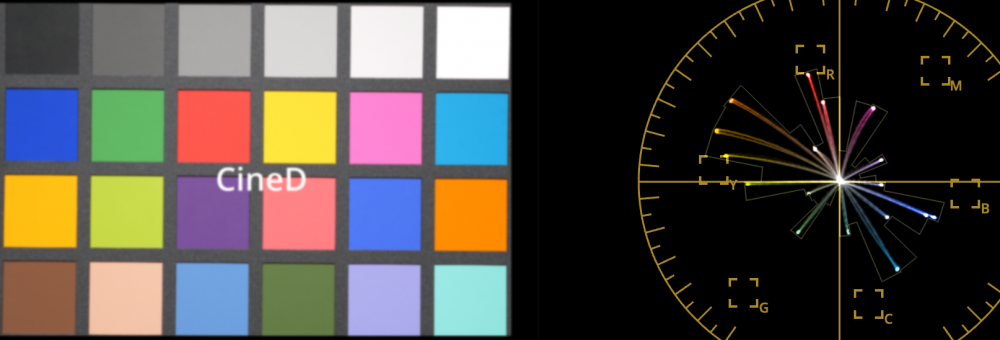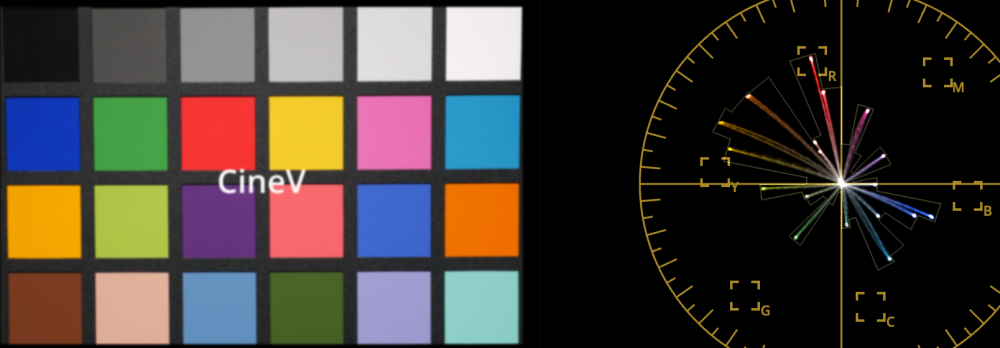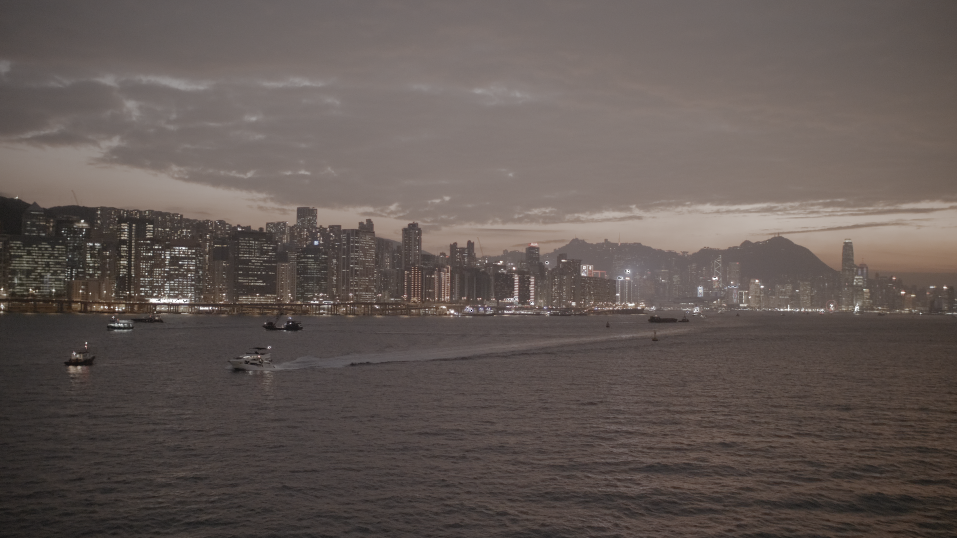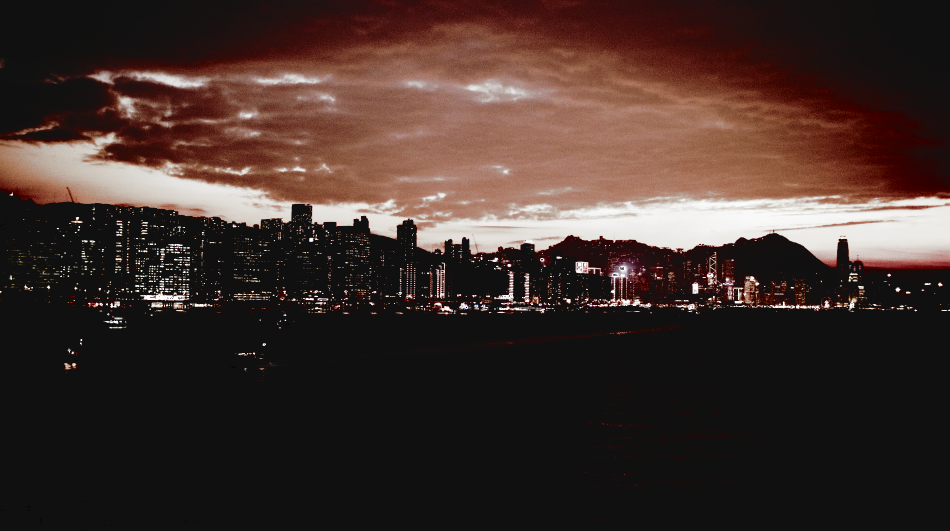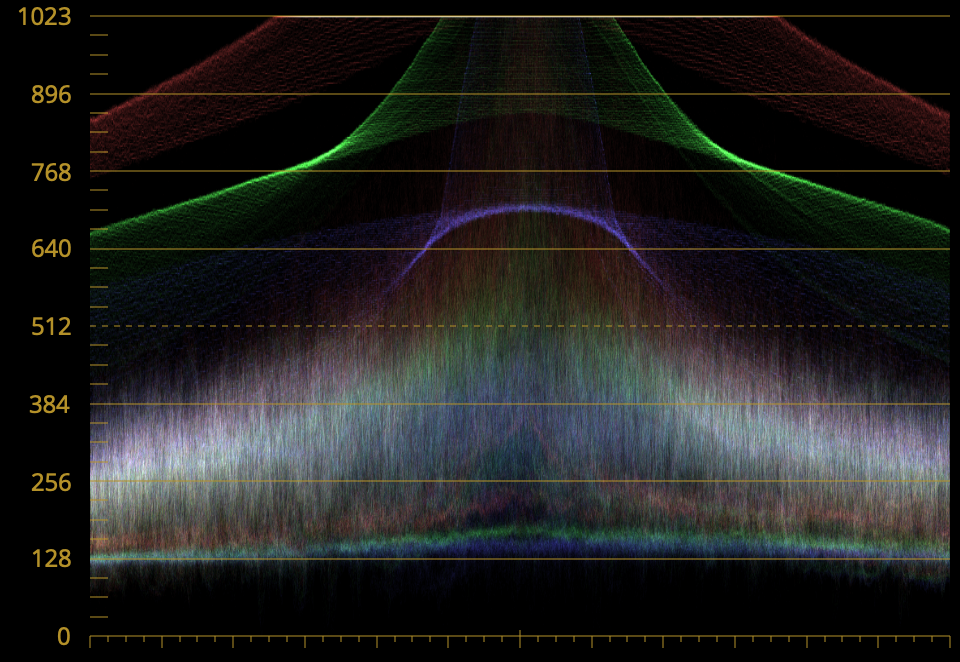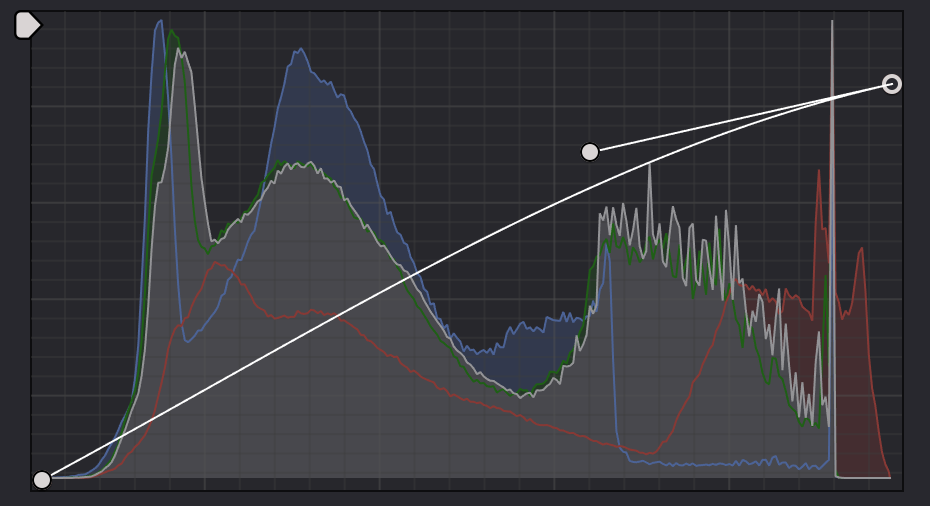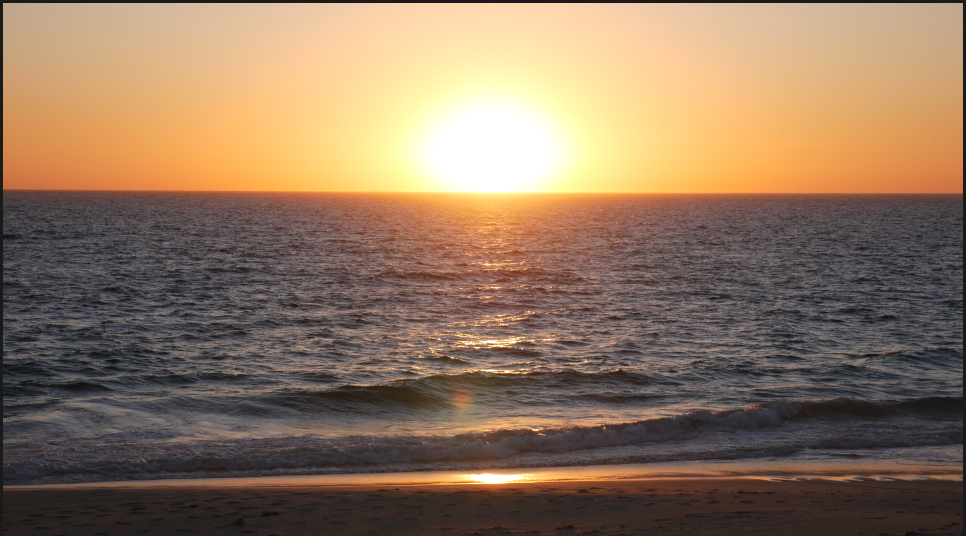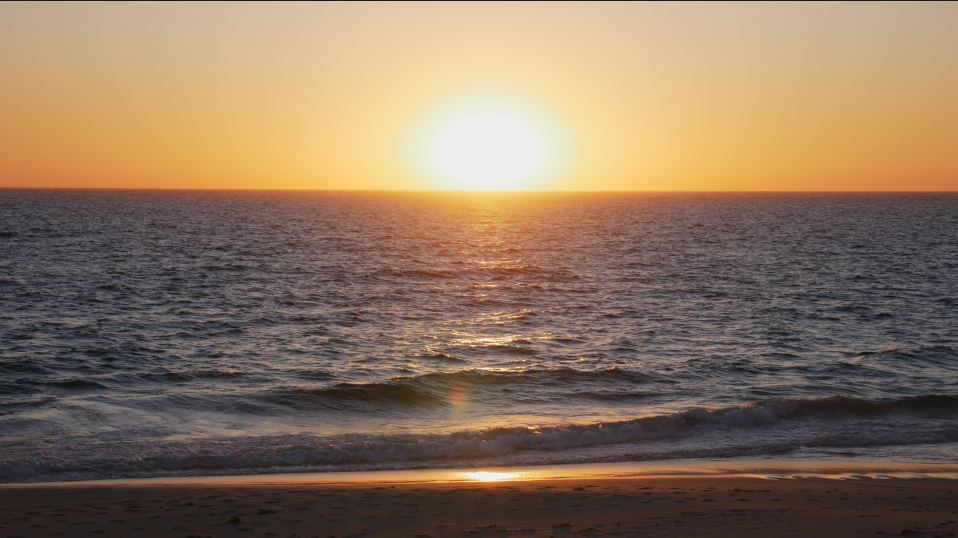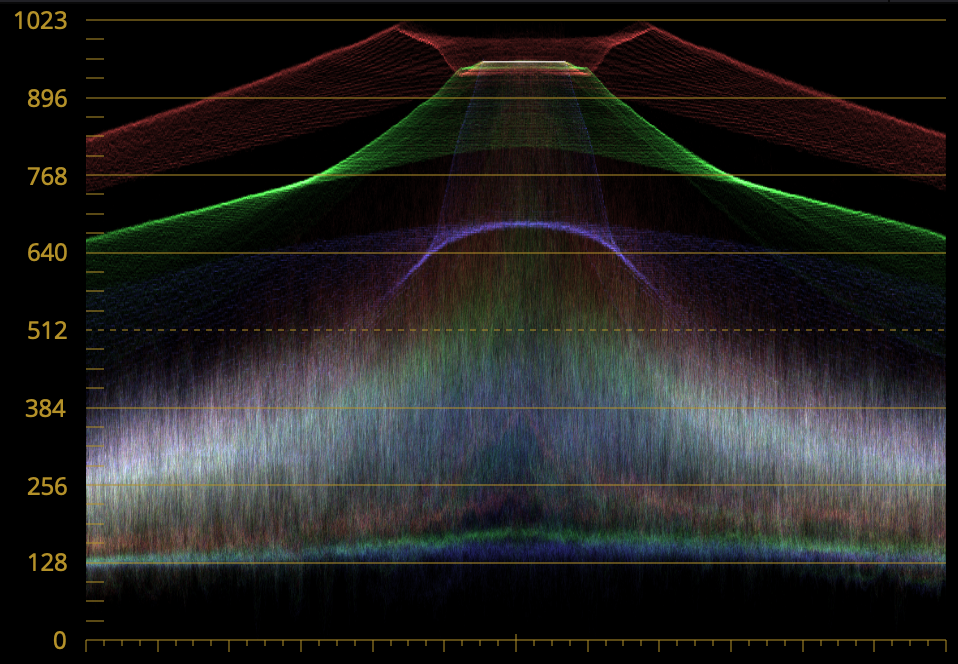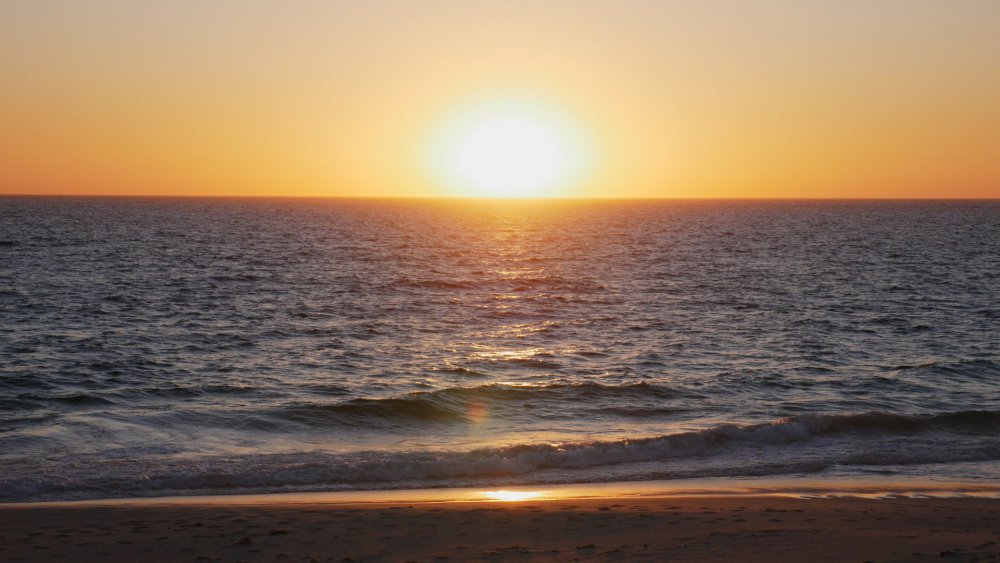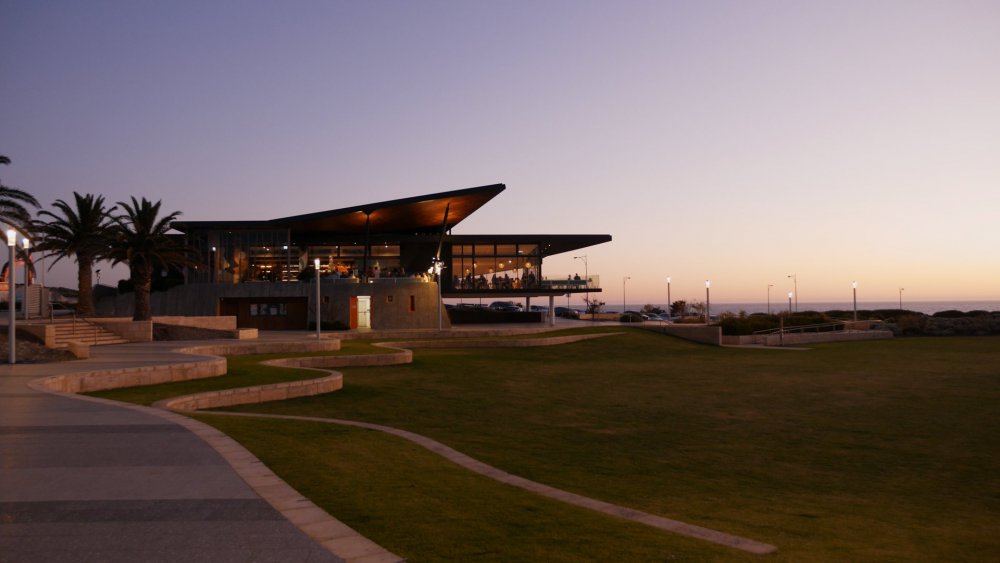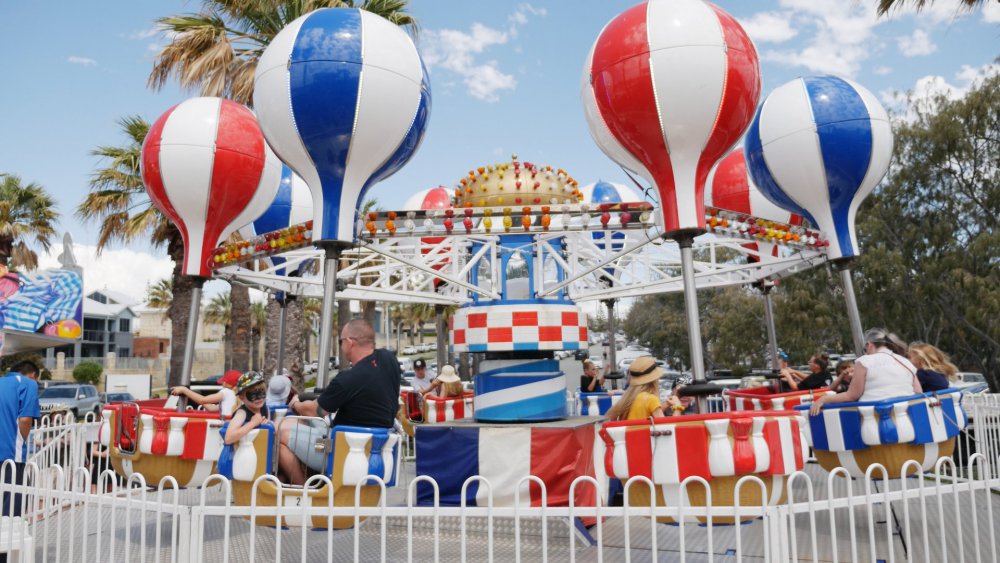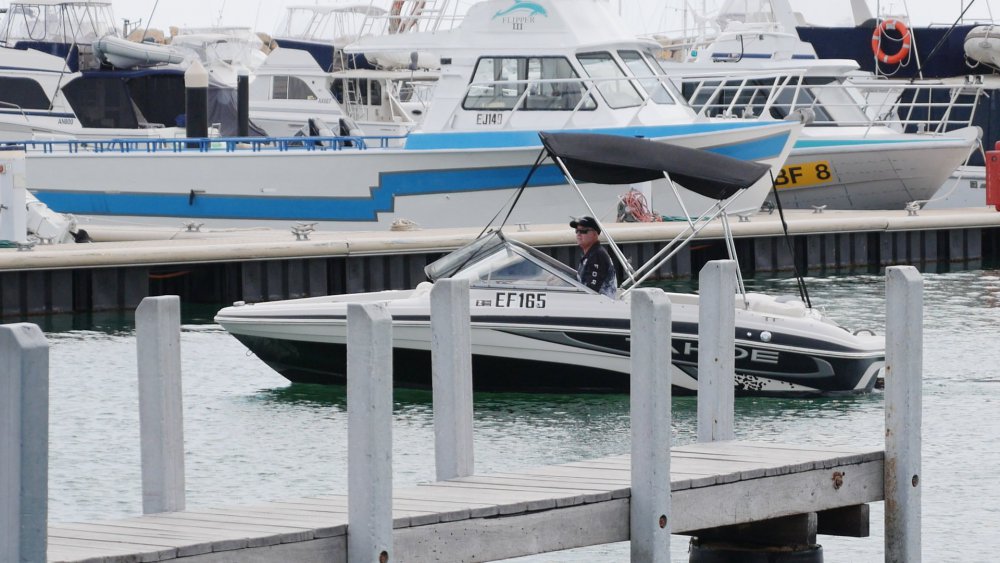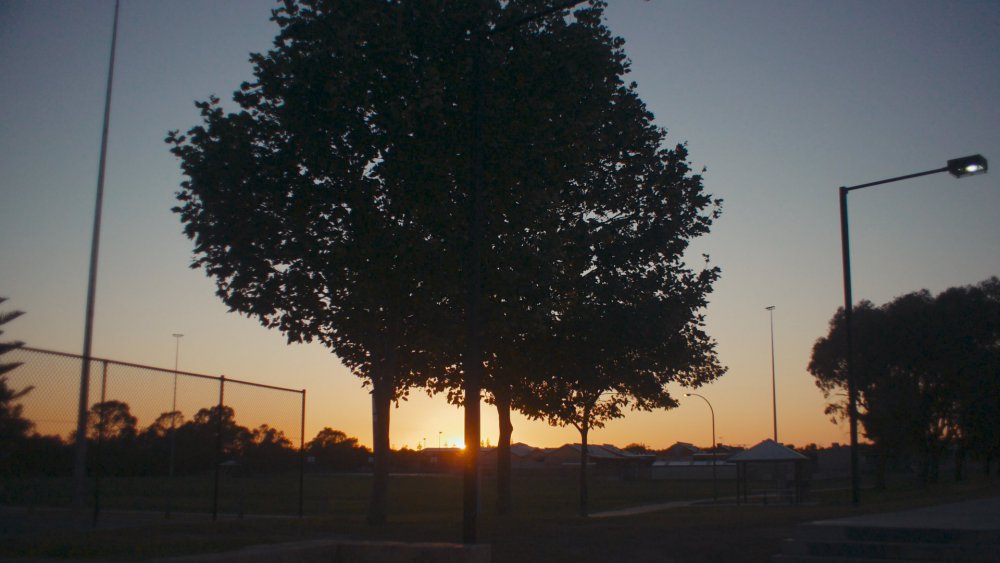-
Posts
7,835 -
Joined
-
Last visited
Content Type
Profiles
Forums
Articles
Everything posted by kye
-
You're not missing the point at all - the "conversion" I've done above is scratching the surface so little that my post is practically a stand-up comedy routine. The vector scope does ignore luminance, so you're right there, but it's more complicated than that. Here's a few thoughts: Firstly, it's not possible to do a "real" match between two cameras unless you know where middle grey is, as that's the luminance level that you will be using these cameras at for exposing skin-tones and so camera profiles typically leave this luma at the set WB but are free to push the balance of everything brighter and darker than this point (e.g., warmer highlights and cooler shadows are very common) and as you're meant to use a colour checker by having the brightest square just under clipping and the cameras have different dynamic ranges the middle grey will be different and might not even be on that scale LUTs are most often 3D LUTs because the transformation is in 3D, meaning across hue / saturation / luminance (HSL). This means that while I've matched the hues at those levels of S and L, the same H could be different at literally every other combination of S and L. Colour profiles and colour science are hugely subtle things, relying on very small tweaks all across the HSL 3D space. To match cameras truly you need to point the cameras at all the combinations of H S and L and then make a transformation that pushes one 3D lattice to the values of the other one. This is what @Sage did in his GHAlex work. I have a theory that even this isn't enough because it sits on top of the cameras WB, but that's a different story. The practical concern of the above is that I have matched a few strongly saturated hues but haven't matched the less saturated ones, which is where the skintones sit. The charts do have some of these, so there's another level I can go to with what I have. As I mentioned above in my reply to @BTM_Pix I also forgot to match the greyscales, but that's subject to middle-grey considerations, so not sure how well I could do that. Having said all that though, I've done simple hue matching (Hue vs Hue, Hue vs Sat, Hue vs Lum) to "match" radically lesser cameras to greater ones before (GF3 to P2K) and as crude as these adjustments are (and they are so tremendously crude as to basically be a joke) the resulting images certainly benefit considerably from that treatment. The spirit of this is really that doing a "conversion" is impossible, my approach is laughably inaccurate, but there are still benefits to be had. Both from learning along the way as well as getting something useful to use afterwards.
-
Yes, I was surprised how similar the GX85 profiles were to the Alexa in terms of overall look. Obviously the Alexa has hugely more dynamic range and codec quality, but colour profiles are something that a manufacturer has to implement into their cameras (unless they're RAW only) and because they're basically just a LUT you can put whatever sophistication into them that you like, and Panasonic seems to have done a great job in this aspect.
-
I'd imagine they might be quite close. After all, same profile from same manufacturer, and the GX85 however budget and physically small is still a high-performing camera - to put it in perspective 4K 8-bit 100Mbps is the same as the Sony A7SII. If you have any tests comparing the cameras it would be interesting to see them.
-
It's early days for this work for me, but I might want to dial something in further in future, in which case that setup looks spectacular! TBH I've *almost* reached my limits (skill/patience/motivation..) with what I've done above, so I probably wouldn't go that much further in terms of matching them. My goal, after all, is "good colour", not to mix the footage between cameras or anything. One thing that I thought of afterwards was that when I said I applied a WB to the Alexa footage, I actually adjusted WB on the Gain and Lift controls, because what was neutral for the highlight square wasn't neutral for the shadow square. I realised afterwards that step 1 for colour matching is to match the greyscales, which I forgot and skipped in the above. My overall impression was that: I was surprised how similar the Alexa, Natural, and CineD profiles are. On the scopes at least - I haven't tried applying it to real-world footage yet. I would have thought that the Neutral would have been more "correct" I would have thought that CineD would have been stronger of a look (which was my impression from looking at footage from it) I was also surprised that the P2K look was so different to the Alexa, and also that it was stronger, but I'd already digested that surprise in the BMMCC thread, so wasn't new 🙂
-
Great looking images! Have you tried playing with sharpening on the C70 footage? I feel like sharpening is a whole skill unto itself, but because all the cameras that YouTubers use are over sharpened, no-one talks about it in those "how-to make your coffee look cinematic" ads tutorials. I'd suggest working out all the ways your NLE can sharpen (of which there are many) and then pull a few test shots into a timeline and apply every type of sharpening at, say, 10 different strengths, making sure to go higher than what you think looks reasonable. Then export it to whatever resolution / codec you deliver in and then sit back and from a sensible viewing distance compare it to whatever you think is natural. A test like that will be some work to do, maybe a couple of hours, but it will answer the question about what method and strength to apply to get your preference. A few hours spent doing a real test will save you dozens of hours farting around here and there and not being happy with the results. I suspect the C70 is one of those workhorse cameras that will be churning out images for low-budget TV and movies, and doing marketing, corporate and wedding gigs too. It's a quieter camera. No-one is making those "I shot a corporate on a C70" videos because they're not noteworthy, like say, shooting a wedding on an iPhone.
-
The WideDR profile was unusable on the XC10. Maybe there's some problem with implementing it on lesser cameras (technical, appetite, politics inside Canon, etc).
-
Now for reference, and thanks to the beauty of standard colour checkers, let's review what the P2K and Alexa look like. From this rather handy video: I pulled various scopes. It's likely to be relatively pointless (and depressing) to compare the GX85 Dynamic Range with these, so I'll skip that and focus on the hues. P2K Primaries: Alexa primaries: Things to note here are: Both these cameras have strong looks Orange and Teal directions are much more saturated than the Green / Magenta directions Hues in the Orange and Teal quadrants are rotated closer to the mid-point, with the Teal quadrant more compressed Both the P2K and Alexa pull the Magenta towards Red and leave the Green mostly untouched The P2K is stronger than the Alexa even, with its Magenta being almost on top of the Red, and with lowered Yellow saturation it's really skewing the colours to the Red / Cyan line, rather than the Orange / Teal line Personally, I think the P2K profile is a little too strong a look for me (you might disagree which is fine) but it's useful to see that the P2K and Alexa are both in the same direction from a "correct" look (with the colours in the reference boxes). As such, I'll proceed to compare the GX85 with the Alexa colours. GX85 Natural: Alexa: GX85 CineD We can't compare absolute levels of saturation because I didn't perform the P2K test, which has also been put through YouTube compression, but we can look at the relative hue and sat of the hues. What I'm seeing: Alexa has similar saturation between Red and Yellow, Natural has Red>Yellow and CineD has Red<Yellow, but these are always adjustable Natural has similar Magenta to Alexa, with CineD giving it more saturation and it being less rotated towards Red Green in CineD seems to match better with Alexa CineD representation of Blue and Cyan is too saturated (comparing to Red as reference) but Natural is also too saturated and with a less accurate match In terms of which one to choose when grading to match the Alexa, I think you could use either profile. The challenge is that you're capturing in 8-bit so you want to match in-camera as much as possible. For this: Both CineD and Natural have the highest shadows of any of the GX85 profiles I tested, so are more likely to contain the whole DR from the camera Levels of saturation are a balancing act, too much sat in camera and you'll clip strong colours, but too little in-camera and you'll be amplifying noise when you boost saturation in post Now to match the CineD to the Alexa. Unmodified CineD Alexa - with colour balance and sat GX85 - "Alexa conversion" (ha ha ha) Just for fun I used the new spiderweb tool thingy in Resolve to match them: Next is to test it on real footage.
-
Now I've "made friends" with the GX85, I'm now looking at its colour profiles. I've installed the CineD / CineV hack from @BTM_Pix so are including these in my testing. In these tests, I'll be: Looking at what the colour profiles actually do, with a colour checker and scopes Comparing these profiles to the colour profiles of the P2K and Alexa Grading selected GX85 colour profiles to match resemble the P2K and Alexa Working out what the best combinations might be and just generally working out what setup I will implement First, what do the colour profiles actually do? I took the GX85, 12-35mm f2.8 lens (at 35mm) in the 100Mbps 4K mode, and shot my colour checker in direct sunlight. I then brought those into Resolve, cropped, and blurred a little for cleaner traces in the scopes. I actually clipped the white square on the checker a little, oops!, but no test is perfect and neither am I, however I think the results should still be useful. Here goes..... Natural - let's use this as the baseline. For those unfamiliar with these kinds of tests, it is worth noting a few things though: Firstly, this profile is NOT NEUTRAL. Anyone who's seen a colour checker in real life can tell you that the colours in the two middle rows (the two below the greyscale) are all about equally saturated - ie, very saturated. These are the colours that are meant to go in the little reference boxes on the scope. Notice how the red trace almost reaches the R box? Notice how the pink and purple boxes look really pastel? Overall the profile is much more saturated in the upper-left (orange) and lower-right (teal) directions. This is a relatively typical colour palette that looks pleasing. Also notice how the colours are rotated towards those two directions? it's especially noticeable in the teal direction where the blue is rotated clockwise towards the Cyan reference box, and the cyan is rotated anti-clockwise towards the Blue reference box. These characteristics give a nice starting point, and are very commonly seen in colour profiles in general, although as the name says, this is a relatively Neutral implementation of that look. Scenery - it's basically the Natural profile with more saturation, except notice the green is pushed slightly towards blue to give a but more hue separation in the greens. Oddly enough, that might help give visual interest with scenery shots! Portrait: Similar to Natural but more saturation (less than scenery) but this one slightly compresses the skin-tone ranges, pulling the yellows towards orange and the reds slightly towards orange too. This helps to mask blemishes and uneven skin. Nice. Vivid is..... vivid. Panasonic really deliver huh! Like natural but with heaps of saturation. CineD. The legend. Lots going on here! Here's what I see: Slight compression of skin-tones and desaturating right on that hue Higher saturation of all colours except yellow-greens (a hue I know I dislike) and mauve (a hue named after an old lady) Also slightly compressing tones in the teal direction CineV which is obviously more contrasty with a much lower black level, and consequently is also more saturated than CineD, but is also slightly more "correct" with some hues being closer to their theoretically correct locations, for example, the Red is now almost perfect. If you take CineD and pull the shadows down then you get something very similar to CineV, only with more saturation (contrast creates saturation). If you then drop the saturation a touch to match, you notice that CineD creates more even saturation between the warm tones and cooler tones, whereas CineV has more saturation on the warmer tones and less on the cooler tones. Note, this isn't a WB difference - this is with the WB set correctly on both profiles. TLDR; Natural profile isn't natural, but is a moderate amount of a relatively common colour profile pushing things towards orange and teal, and compressing skintones for more flattering skin rendering. Other profiles kind of build on this foundation and kind of do what they imply with their names. CineD and CineV are a bit more complex again, with the main difference being the amount of contrast.
-

How Jordan of DPReview showcases flexibility of RAW video (lazily)
kye replied to The Dancing Babamef's topic in Cameras
They're in the YT algorithm game, which oddly enough, doesn't take saturation into account, but does take into account how often you post. Unless you're seriously talented, the best strategy is to post mediocre videos more often and if you have any spare time then you're better off putting them into gaming the system with clickbait-y titles and thumbnails. Camera technology content (and all technology content really) is time-critical and basically disposable, so it's basically about pushing things through as quickly as possible at the minimum quality to retain viewers. -

Super tiny Sigma 28-70mm F2.8 for mirrorless camera (E / L Mount)
kye replied to Andrew Reid's topic in Cameras
Interesting. Didn't realise that the UK was a hotspot for people trying to be cinematic. -
The brand does start with A and end with X does it? 😎😎😎 If I didn't care about size (or budget 🙄) then I'd be all over some of those S16 cine lenses...
-
I should also say that nailing WB in post, when shooting in difficult lighting conditions and without a grey card, has actually been one of the most difficult skills I've had to learn as a colourist. I found that routinely I would struggle to get a shot looking ok, but if I posted it to the colourist forums they'd reply super quickly with shots that just looked right on, and when I copied them I'd found they'd just done a simple WB adjustment, added contrast and saturation. I also find that I see small WB errors regularly on videos where people shoot in mixed lighting, even on those "cinematic" videos, so I suspect I have become attuned to seeing it and knowing what direction to push it in. The more I learn colour grading the more I realise that stunning colour grading isn't using 27 fancy controls and adjustments, it's using the very very basic controls and having serious knowledge about how to use them. Great colour is done much more simply and much more skill-fully than you'd think. There's a common saying "simplify for results, complicate to profit" and the YT colourists are definitely interested in profit. There's not much of an audience for colourists who just hammer out great looking grades with the same simple tools over and over again, and the only real advice they can give is "go and grade 10,000 shots using only the LGG controls". (BTW, that's really good advice!)
-
My edits tend to not have a shot longer than a few seconds, so in that sense things don't normally change that much and I'll grade each clip on the timeline separately. However, a really quick trick in Resolve is to grade a clip how you want it to appear at the start, then copy it and adjust the grade so it's it how you want it at a particular time, then have the second clip fade in over the top of the first clip. It's an easy way to "automate" every parameter available rather than just what your NLE provides in terms of "automation" features. I suspect your question assumes that the AWB is the culprit for the colour shifting over the course of a shot when everything else remains static, but I haven't found this to be the case really. AWB and exposure in general will shift when the environment shifts, such as lighting changing (eg, sun going behind a cloud) or you moving the camera (panning or walking outside from inside etc). In these situations you'll want to have an adjustment in post anyway, and cinematographers will do things like pull-aperture to try and keep a reasonable exposure. In a sense, the camera auto-changing these things is just a robot doing these things for you, that once again, you would want to do yourself anyway and having it done mostly in-camera just helps get the compressed file closest to where you need it to be. Maybe you've had bad cameras that "hunt" with their AWB functions? It's never been a problem for me.
-

How Jordan of DPReview showcases flexibility of RAW video (lazily)
kye replied to The Dancing Babamef's topic in Cameras
In my experience, there are two kinds of (serious) codec tests that people do. The first is for when you have controlled shoots and you are trying to understand the absolute sweet spot of the camera. For this, you shoot a controlled scene using a model (or two), test charts, and anything else you might think is usable, and you shoot it at 0, and then under and over by 1 stop, 2 stops, 3 stops, 4 stops. Then you bring everything back to proper exposure in post and look at the skin tones and noise and other image attributes. This is used in seriousness by professional cinematographers who do the tests and then work out that perhaps the sweet spot is +0.5 stops, and they'll shoot the camera there for every shot on 8 and 9-figure productions because that's the best place for skin tones, or whatever. "You expose camera X at X stops under/over" is common knowledge once a camera comes out and is tested and everyone will do that - why wouldn't you? The second is for when you're not shooting in controlled shoots and you want to know how far you can push the camera. For this, you shoot a range of situations and deliberately push the camera in all sorts of ways, under and over exposing in a range of circumstances, doing things like in low-light under exposing with native ISO and raising in post vs rising ISO in-camera etc, filming in mixed lighting and fixing in post, filming in radically contrasty lighting, filming highly saturated things like neon signs and car tail-lights to see how it handles extreme saturation, etc. These tests are designed to work out how far you can push the camera. Taking one shot is suitable for neither scenario and tells you very little. It's.....lazy. I'd suggest that the people who use 5D with ML are actually out shooting rather than talking about cameras. It's one of the closest matches there is for an Alexa (the others being OG BMPCC / BMMCC, and maybe Sigma FP, etc) so once you get that setup it's camera choice = solved so move onto next choices like lenses and lighting and composition and story and then navigating the entire process to make and publish something. Here's a test I did with the GH5 10-bit 150Mbps mode, which isn't even the GH5s best mode BTW, in trying to break the codec. I chose a flat looking scene and tried to break the flattest looking part of it (the clouds) to see what was there. This is informal but is an example of a test to see where the limits of the 10-bit are. I'm not in the R3 target market (or Canon Cripple Hammer target market for that matter) but if I was spending $6K on a camera then I'd want to know: where the sweet spot of the camera is how far I can push the darn thing and still get a "nice" image (ie, acceptable for a main shot - according to my standards) how far I can push it and get a shot that is still usable in an edit (ie, for 1 second) ..and you want to see some work that puts things in context? Sure. I am an amateur who shoots travel and events for family and friends in available lighting (which is absolutely awful lighting BTW). Here's a couple of videos where the camera was pushed beyond its/my capabilities. and and lest you think I don't know WTF I'm doing, here's a test video I shot where the camera was within its capabilities. Of course, all of this is hypothetical anyway, because if I was spending that much on a camera (the R6 costs about as much as all the cameras I have ever purchased put together BTW) I'd pretty much be asking Tarot Card readers for their opinion on it before listening to Jordan! -
It really depends on where you're filming. I shoot exclusively in available light, in realtime, without directing anything that happens. What happens happens, I shoot what I shoot, and I get what I get. This often means I shoot in situations with lighting so terrible it would make you cry. Have you ever shot something on the wrong WB setting and couldn't recover it in post because it was too badly damaged? I have done tests to see how much latitude there is and it's not much. Have you ever shot something in post and the WB controls in your NLE max out and you have to apply colour correction in multiple passes to return a shot to neutral? I have. Here's a final grade I did of a little film I shot with the GF3 getting some food one evening: Those last shots are interesting. Here's one SOOC: That shot was filmed with AWB. The lighting was so off-colour that it maxed out the cameras AWB adjustments. Had I chosen a fixed WB for this shot the SOOC would have been way worse, and probably unusable. Had I stopped to manually set the WB, it wouldn't have helped - the camera didn't have enough latitude. Notice from the scene that there are several sets of lighting in the communal area, and every truck has its own internal lighting, and some have their own external lighting too. These lights will have been chosen to be the cheapest possible - high CRI LED lighting these are not! Other shots were completely fine, like this one SOOC: In practice, AWB will take you towards what the camera thinks is the right WB. It won't get it perfect, but it will take you in that direction. Had I shot this with a fixed WB, I would have been trying to push the GF3s (rather meagre) 17Mbps further in post than I had to. The sequence is this: Camera reads RAW data off the sensor Camera applies WB (fixed or AWB) Camera applies colour profile, compresses stream and writes video to media You adjust WB in post The bottleneck is the colour profile of the camera followed by the compression. If fixed WB will get the compressed stream closer to perfect then do that, but I find most of the time that AWB helps me get close in difficult situations, and the rest of the time almost never needs to be touched.
-
Oh, and to clarify my earlier poor wording, the waveform where everything is clipping (below) is SOOC, and doesn't have the curve applied. The bottom waveform with the red showing is the one with the curve applied.
-
Oh yeah, and I always have AWB on. My rationale is that I'm always wandering between different lighting conditions and cameras now are pretty smart about things, so regardless of if I was doing WB manually or AWB I'd have to adjust it in post anyway, so I may as well just use AWB because it's more likely to get it in the ballpark, which helps when not shooting RAW to get it as close as you can in-camera. Having said that though, I don't recall having to adjust this camera yet, so it seems good.
-
Those shots were Natural profile, unmodified, and with a curve to bring the highlights down and have a little highlight rolloff, and the saturation boosted to about 107%. Here's the curve: The challenge is that when you have a curve to clipping, your waveform looks like this: Which means that for that whole area where the red is clipping the colours shift to yellow, like this: BUT, somehow the red channel has extra info that is recoverable (IIRC this isn't the first time I've seen colour information above 100%) so if you pull it down a little then you get this: and this waveform: There are still some rather odd things happening to those red levels in the parts we recovered, but they do give an interesting hue to the areas just before clipping. Not sure if that helps? I've found it relatively easy to get great sunset shots with almost any camera, so either it's the colour rendition of the cameras I happen to have chosen (possible - Panasonic is no slouch) or it could be the lighting here. In other news, I have an old Yashica Auto Yashicor 28mm f2.8 m42 lens that I bought super cheaply as it had damaged front coatings and I've been searching for a vintage walk-around lens for the GX85. I had put it in the discard box due to it's terrible IQ wide-open but it turns out that stopping it down a stop (or half a stop) cleans up the image almost completely, so I took it for a test drive and I think I might be sold on it! GX85 + Yashica 28/2.8 + SB + Natural profile SOOC ungraded. Once again, filming in golden hour is probably making this lens look way better than it should look. I have plans to start exploring the colour profiles and colour performance of the GX85 soon, so will report back on what I find.
-
They call them the Trinity of zoom lenses for a reason! One thing worth considering with the Sony cameras is the Clearimage zoom, which is very high quality. From what I saw (watching through the 4K YouTube compression of course) was that it was invisible up to about 1.4x magnification. I also recall from the A73 that you could punch in to a 1:1 (?) 4K mode, which also gave a 1.4x magnification. Combined they give a 2X factor, which you may find high quality enough to use to extend the long end of your 24-70. It's a tough thing, moving from a 16-35 + 24-70 to a 16-35 + 35-150. If it were me, I'd be thinking about: How many of your shots are wider than 35mm How many times those shots occurred after a shot longer than 35mm How many times that transition had to be done in a hurry, or what the time cost would be if you had to change lenses constantly How many times you could use the 1.4x crop / Clearimage zoom on the 16-35mm to get a longer shot (and therefore avoid changing from the 16-35 to the 35-150) How many times you could use the 1.4x crop / Clearimage zoom on the 24-70mm to get a shot longer than 70mm What the optical performance of your lenses is when wide open (as a 1.4x or 2x crop into their image circle will reveal softness or other issues) My travel kit is 7.5/2 + 17.5/0.95 + 42.5/0.95 (FF equivalents of 15/4 + 35/1.9 + 85/1.9). I originally had the 17.5 and was using a 58mm as the longer lens but I found the gap from 17.5 -> 58 to be too large (3.3x) so I bought the 42.5mm (2.4x). The 17.5mm (35mm) stays on the camera most of the time so that's the default lens. However, I bought that kit while I was filming in the GH5 4K mode which I could get a 1.4x zoom by punching into the sensor. I have since switched to 1080p to get ALL-I and therefore eliminating the need for proxies in my workflow, and in that mode I can engage the 2x digital zoom, which creates a 1080p image by downsampling a ~2.5K area of the sensor, and is higher quality than the 1:1 mode. This means that instead of the 35mm cropping to a 49mm equivalent and having a large gap between that and the longer prime which was 116mm equivalent, it means that the 35mm crops to a 70mm which is a lot closer to that 116mm equivalent. So I now have a 35mm(70mm) then an 85, which you could argue isn't so useful because they're so close together. Had I known this before I bought the 85 equivalent, I might have gone in a different direction. I guess I say all this to suggest that the crop/zoom functions can have a real impact on your lens requirements and should be factored in before you spend real money on glass.
-

Super tiny Sigma 28-70mm F2.8 for mirrorless camera (E / L Mount)
kye replied to Andrew Reid's topic in Cameras
That's a nasty cough you've got there... I'd suggest working out the cause of it and eliminating it from your lifestyle 🙂 -
Oh yeah.. I guess I was so amused by the USD$6,000 R3 that while not rendering me completely speechless, it did befuddle me significantly! Getting smacked in the face with the Canon Cripple Hammer is likely to leave you significantly dazed....
-

How Jordan of DPReview showcases flexibility of RAW video (lazily)
kye replied to The Dancing Babamef's topic in Cameras
Now now, he's a camera reviewer who reviews cameras for making camera reviews, you have to keep a hold of your expectations! These are the same people that keep making endless "how to get cinematic images" videos but for some unfathomable reason keep talking about new cameras and higher resolutions when the people who actually make cinema have basically been using the same cameras for a decade. -
The more I use the GX85, the more I like it. I've taken it out with the 12-35/2.8 a couple of times now, including a street festival on the weekend where I got a bunch of shots of a friends kids running around non-stop, and the camera and lens kept up, even at F2.8 the whole time. Some beach visit sample images from the 12-35mm F2.8 (probably wide open).. and the festival outing, also 12-35mm f2.8 wide open, but this includes some shots using the 2X zoom mode too.. and a couple from an outing with the Cosmicar 12.5mm F1.9 wide open (and cropping into the image)... The 12-35mm images are almost SOOC using the Natural profile (I hadn't put Cine-D on yet), just with some slight tweaks in post, but the Cosmicar ones above have been graded under a Kodak 250D / 2393 emulation process, which did surprisingly little to the colour actually. The more I use the 12-35mm the more I appreciate a zoom lens for just getting shot after shot in fast situations, which is pretty much the key to having lots of options in the edit and keeping an edit fresh with lots of different types and compositions of shots. I'd really like a longer lens as I got quite a few shots at 35mm with the 2X engaged, so I'm contemplating the 12-60mm F2.8-4 which seems to be a good match from the reviews I've seen. Curious to hear others thoughts on this. I found the Cosmicar a little challenging to work with as I composed for the screen and was then surprised in post with how much crop I needed to apply, so had a few shots where I was chopping peoples heads off etc. I've ordered a cheap 28mm F2.8 m42 lens to go with my m42 speed booster, which will give a 43mm FOV, which is a little tighter than the 12.5mm Cosmicar which gives about a 35mm FOV once you crop into the image circle. I'll have to see how I go with it. I'll need a 22mm lens on the SB to give a 35mm FOV and those aren't super common in m42 mount! The alternative is my 17.5mm Voigtlander which is 38mm on the GX85 but isn't exactly vintage, so I'd have to look more seriously into filters to get similar flare characteristics (which is the part I love about vintage lenses). The stabilisation is really good, and in combination with the 12-35 is just spectacular, and my regular camera is a GH5 so I'm guessing I'm not easily impressed. It really makes me feel like shooting. Great stuff!
-
Looks great, but looks just like Magic Lantern on the 5D, only with a higher resolution / less cinematic image. You could downscale, but it's a small bump for a large price increase. IIRC my new GX85 gives you zebras, focus peaking and waveform at the same time. For $600, which includes two lenses. and it's not a dedicated video camera either. LOL. Canon.
-
Imagine a telecommunications company that had an internet department and a telephone department. They decided that the internet department should be segmented from the telephone department so they release modems for computers only and refuse to do wifi because then it could be accessed with smartphones, and they refuse to release smartphones because they believe that telephones should be used for voice calling and SMS messages only. How do you think they'd go? World leader in telecommunications? Would this segmentation bring them great fortune? Yeah.



